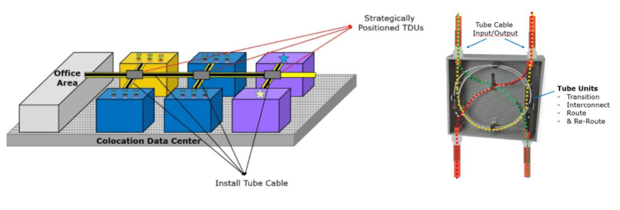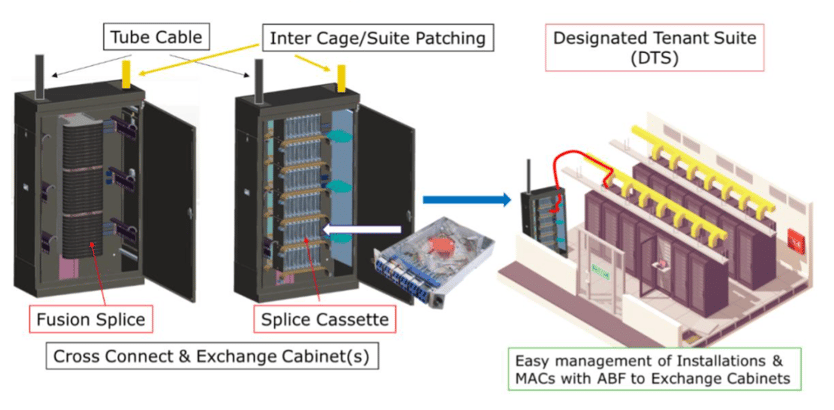In last month's post, we learned more about air blown fiber in colocation data centers with Sumitomo Electric Lightwave.
Today, we'll take a look at those 3 easy steps to install SEL's FutureFlex ABF cable. Read on below!
Step1: Create an End-to-End Tube Cable Pathway
SEL’s FutureFlex ABF offers tube cable counts and types of tubes to fit any installation environment and network volume requirement.
| Jacket Rating | OFNR, OFNP, I/O LS, and OSP |
| Additional Tube options | Armoring |
| Tube Counts | 2, 4, 7, 12, 19 and 24 |
The ABF system installation includes a tube cable distribution unit (TDU) which facilitates tube cable transition, interconnection, routing and re-routing.
One of the greatest advantages of using ABF is TDU capability. TDU allows tube cables to be distributed into smaller counts. For example, a 24 count tube cable can be separated into 2 x 12 tube cables, 6 x 4 tube cables or any number required to meet a colocation data center’s needs. In addition, network transition, interconnect, routing and re-routing can be all done in the TDU without fusion splicing!

Step 2: Select & Install the Fiber Bundle
The fiber bundle is selected based on the tenants’ and number of tenants requirement such as speed, bandwidth, mode, data volume and security. The FutureFlex ABF product line includes a wide range of fiber bundles shown below.
Options:
-
- Fiber Types: OS2, OM1, OM2, OM3, OM4 and OM5, most are Bend Insensitive Fibers (BIF)
- Fiber Counts: 2, 4, 6, 12, 24, 48 and 72
Did you know?
SEL’s FutureFlex fiber bundle outer jackets are made by PEF material for easy access to fibers.
Step 3: Terminate the Fiber Bundle Units at Demarcation Points
Whether working with thousands of fibers or a handful of fibers, SEL’s Fusion splicer, Splice Cassette, and Hardware makes termination easy. A newly released Splice Cassette has special buttons to easily attach or remove a cassette from the rack, and access cables easier than before.
SEL offers a blowing head specifically designed for the FutureFlex ABF system which makes cable installation easy. After tube cables and TDUs have been installed, the blowing head can blow approximately 3,000 feet in 30 minutes with only two installers. Even if fiber has been previously installed in the path, the fiber bundle can be removed which simplifies switching to higher count fibers, or changing to a different fiber mode. Removed fiber can be utilized or repurposed for other tenant’s or application needs. The removal process is easy and takes less time; the fiber can be blown out by using the air assist only. All vacant pathways can be used for future expansion and unlike regular cables, the data center owner only purchases fibers based on the tenants’ required capacity and when that requirement needs to be fulfilled. With FutureFlex ABF system, there are no dark fibers and there is no need to purchase extra/unused fiber upfront for possible future expansion. The colocation data center only purchases the fiber it needs now and then buys more as it is needed.
ABF benefits are not only the cost effectiveness and ease of connections, ABF also reduces the risk of work place injuries. Once tube cables are installed, no ladder or lift are required. The fiber bundle is fed from the reel and placed into the blowing head and blown through the tube cable pathway. There is no need to access into the overhead cable management for installation or removal, which typically require ladders or lifts which pose risk of injury and also block traffic paths which may hinder the progress of other network projects or activities within the Colocation Data Center.

That's so many benefits!
For a quick bulleted list of the many benefits of ABF for Colocation Data Center, take a peek below…
- Easy and Fast installation with minimal labor
- Future expansion or replacement with a different type of fiber is an option
- Easy removal of inactive/outdated fiber
- Non-disruptive
- Safe installation – No ladders, No lifts
- No congestion build-up in the cable management trays
- Dedicated tube for large customer
- Wide selection of tube types and cable counts
- One tube cable can install up to 1728 fibers when used 24 tube cable with 72 pliable ribbon fiber bundle
- SEL’s new pliable ribbon makes fiber treatment fast and easy
- SEL’s new mini-HSX exchange cabinets and FOX splice cassettes extend the ease of managing installations and MACs
Thanks for reading on with Sumitomo Electric Lightwave! Click here to learn more about SEL's product base, or shop with Sumitomo below.



.png?width=58&height=58&name=X_logo_2023_(white).png)
